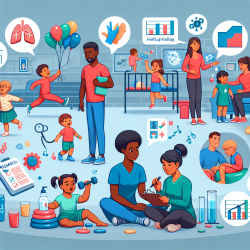Introduction
Understanding health-seeking behaviors is crucial for reducing child mortality, especially in low and middle-income countries (LMICs). The study titled Listening to Caregivers: Narratives of Health Seeking for Children Under Five with Pneumonia and Diarrhea: Insights from the NIGRAAN Trial in Pakistan provides valuable insights into the caregiving context and decision-making processes in rural Pakistan. This blog aims to help practitioners implement these research findings to improve health outcomes for children.
Key Findings from the NIGRAAN Trial
The study highlighted several critical factors influencing health-seeking behaviors:
- Role of Joint Family System: The joint family system plays a significant role in decision-making, often delaying formal healthcare consultation due to reliance on home remedies and the authority of elders.
- Perceived Quality of Care: Caregivers showed a preference for private doctors over public sector doctors due to perceived better quality of care and shorter waiting times.
- Financial Considerations: Financial constraints significantly impact the decision to seek healthcare, with many caregivers opting for home remedies or over-the-counter medicines initially.
- Educational and Socioeconomic Status: Literacy and financial stability influence the ability to identify symptoms and seek timely care.
Implementing Research Insights
Practitioners can leverage these insights to enhance their approach to caregiving and health education:
1. Engage the Entire Family
Given the influence of the joint family system, health interventions should target not just the parents but also the elders in the household. Educational programs should include sessions for grandparents and other influential family members to ensure a unified approach to health-seeking behaviors.
2. Improve Public Sector Healthcare Perception
Efforts should be made to improve the quality of care in public health facilities. Training programs for public sector doctors to enhance their communication skills and reduce waiting times could help in changing the negative perception among caregivers.
3. Financial Support Mechanisms
Introduce financial support mechanisms such as subsidies or community health funds to alleviate the financial burden on families. This can encourage caregivers to seek formal healthcare services sooner rather than relying on potentially harmful home remedies.
4. Focus on Health Education
Health education programs should be designed to improve literacy about the symptoms and severity of pneumonia and diarrhea. These programs can be conducted in local languages and tailored to the educational level of the community.
5. Utilize Community Health Workers
Community health workers can play a pivotal role in bridging the gap between caregivers and formal healthcare services. They can provide home visits, offer initial assessments, and guide families on when to seek professional medical help.
Encouraging Further Research
While the NIGRAAN trial provides valuable insights, further research is needed to explore the effectiveness of these interventions in different contexts. Practitioners are encouraged to conduct localized studies to understand the unique challenges and opportunities within their communities.
Conclusion
Implementing the findings from the NIGRAAN trial can significantly improve health-seeking behaviors and outcomes for children under five suffering from pneumonia and diarrhea. By engaging the entire family, improving public healthcare perception, providing financial support, focusing on health education, and utilizing community health workers, practitioners can create a more effective and responsive healthcare system.
To read the original research paper, please follow this link: Listening to Caregivers: Narratives of Health Seeking for Children Under Five with Pneumonia and Diarrhea: Insights from the NIGRAAN Trial in Pakistan.










